Happy Holidays from Aquaveo!
By aquaveo on December 25, 2019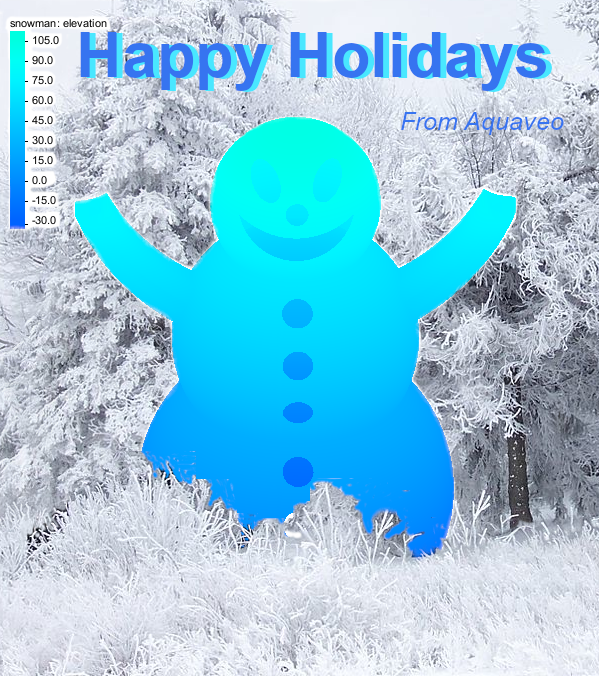

Have you ever wondered what the difference between projection and reprojection is? Have you ever needed to convert a projection from one type to another in GMS, SMS, or WMS (collectively known as XMS)? The use of projections in WMS can be confusing, so the following should provide further clarification.
Projections can be associated with individual data objects, either in the object data file itself or in an associated *.prj file. If XMS cannot find a projection, the object will be left as "no projection," or, when new objects are created, XMS will assign the display projection to it. You can specify an object's projection by right-clicking on it and selecting Projection. Note that this projection must be the same as the original projection of the data; specifying an incorrect projection will result in data issues.
"Reprojecting on the Fly" occurs when datasets or objects from multiple projections are loaded into a project, where the x and y values would not otherwise overlap (i.e., the data would be displayed in two or more distinct locations). The different projections for these data will be "reprojected on the fly" to match the display projection such that the data objects will line up. Note that this does not change any *.prj files or the projections that are set for each object; it is an automatic function internal to XMS used for display purposes.
If you need to convert from one projection to another, this can be done by right-clicking on it and choosing Reproject. To use this command, the data must first have the correct projection specified. After choosing Reproject, the command will prompt the user to select a new projection, the data will be converted to the selected projection. If a *.prj file is associated with the object (such as a TIFF), reprojecting the object will change the *.prj file. Reprojection on the fly is usually sufficient for most applications. Please note that there are some limitations for reprojecting.
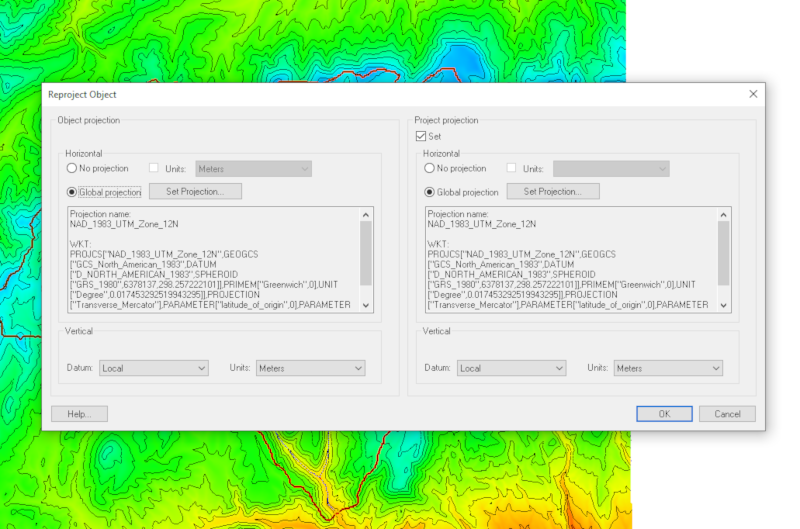
Once the datasets are referencing their projection correctly, XMS should reproject them on the fly to match your display projection. If you don't have a display projection set, you can do so by selecting the Display menu and choosing Projection. At that point, if you would like to reproject your scatter(s) into the same projection as the display projection, you would be able to do so.
Now that you see the differences between projection vs. reproject try them out in XMS today!
Have you ever needed to add an abutment, embankment, or other feature to your mesh and found it a struggle? We have some good news for you: SMS includes a function called Feature Stamping that is useful for this exact situation.
Feature stamping allows you to add man-made structures to an already created mesh by means of a stamping coverage.
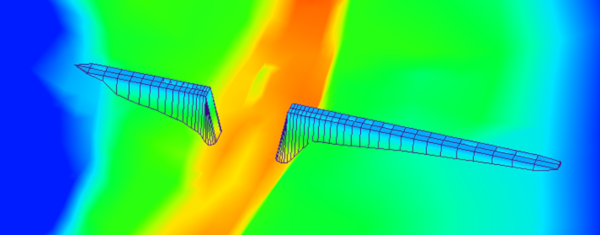
You can find out more about this process in this wiki workflow.
There are, however, a few items to keep in mind when attempting to use the feature stamping tools. In this post, we’ll cover some of the most common, and how to troubleshoot them.
In order for feature stamping to be the most effective, it is necessary to enter them into a mesh that is already stable. Some items to look for include:
You can find much more about creating quality meshes on here our blog.
Disjointed vertices are points in the scatter that have not been connected to triangles or quadrilaterals in the mesh. Feature stamping will fail if there are any disjointed vertices in the mesh.
There are two options for fixing this:
Feature stamping is usually linear, following a centerline.
If the structure is too large, or crosses over with other structures, it often has problems properly integrating with the mesh.
You can find examples here of when features are considered to be overlapping.
As long as your stamping features are reasonable in size and don’t interfere with each other, you should be able to successfully stamp your man-made features into the mesh.
Feature stamping is a very useful, but sometimes under-utilized, tool. Try out the feature stamping function in SMS today!
After completing a MODFLOW groundwater model in GMS, have you needed to see the aquifer water level? Viewing the water level can aid in visualizing the saturated thickness of an aquifer. The water level can be viewed by doing the following:

Additional information about the MODFLOW display options, including the Water Table option, can be found on our wiki.
After viewing the water table, it is possible to save the spatial 2D data for the saturated thickness (water table thickness from the aquifer base).
There isn't a shortcut way to save the 2D water table thickness. However, the desired dataset can be created by converting the head and bottom elevation datasets to 2D datasets, and using the dataset calculator to create a dataset of the difference between the two datasets. The workflow is outlined below.
Now that you know how to view and save a water table, try it out in GMS today!
A project that Aquaveo is proud to be part of is bringing forecasting data to people around the globe through GEOGLOWS.
Because many countries around the world don’t have the resources to predict droughts and floods, they struggle to keep a steady supply of food and stable economy. Companies such as the World Bank, ESRI, NASA and others have partnered together to create a warehouse of apps to predict a 15-day forecast of more than 200,000 streams across four continents to help anyone from farmers to politicians be better prepared for any changes.
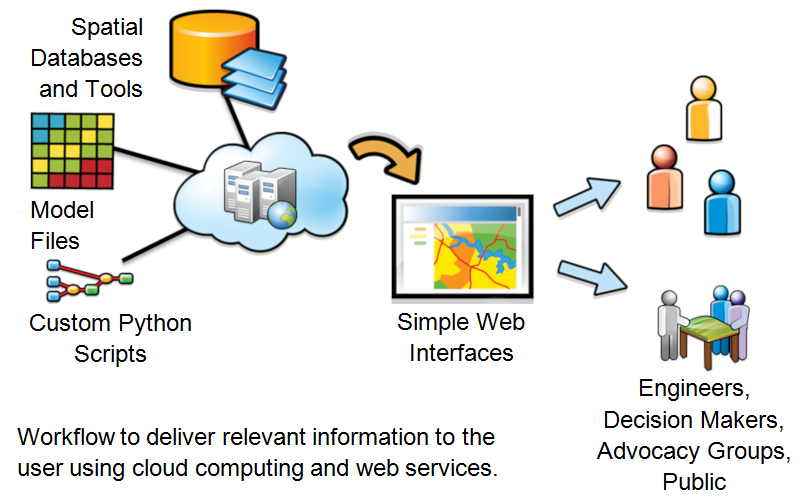
Though Aquaveo only came onto this project recently, designing an API for these apps, we are very excited to be helping countries around the world such as Somalia and Ethiopia overcome their struggles to stabilize their economies, and be better prepared for disasters.
Two of Somalia’s main rivers, the Juba and Shebelle rivers, originate outside of their boundaries in Ethiopia and Kenya, which is a major obstacle for Somalia. A streamflow forecasting system helps improve water management in the country by providing much needed transboundary water information--helping them foresee flooding within days allowing them to take action.
Ethiopia gets between 40–87 inches of rain a year, both because of this much rainfall and in spite of this much rain, Ethiopia is vulnerable to floods, droughts, and chronic scarcity in several parts of the country. A streamflow forecasting system helps improve water management in the country by providing the necessary data to make decisions and develop action plans.
Since the formal creation of the initiative in 2017, the most significant element of GEOGLOWS has been the application of Earth Observations (EO) to create a system that forecasts flow on every river of the world while also providing a 35-year simulated historical flow. We can now deliver reliable forecast information as a service, instead of all the underlying data that must be synthesized and computed locally to produce the necessary information.
Aquaveo have been proud to be part of GEOGLOWS and other initiatives. Watch our website to see news about more projects like this in the future.
In SMS, designing a good 2D hydraulic model from the start gives the best results. A poorly designed model can give bad results, cause model errors, or even keep the model from converging. And while it may seem easy at first to design a good model, there are plenty of potential pitfalls that can come up if you are not careful.
The following tips, broken down into five areas, can help improve any model.
Pay attention to your terrain data. You can't set up a good model without a good foundation, and terrain data is your foundation. There are four things you will need to spend time getting right:
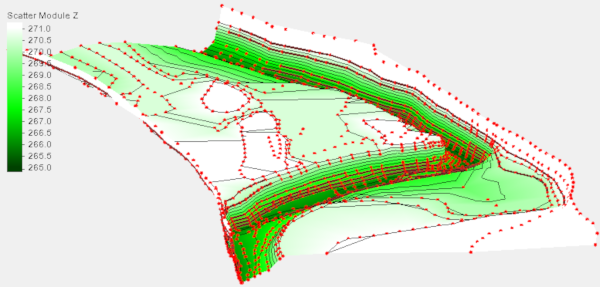
Use an appropriate number of elements: size does matter, more is not always better. This is mainly because the time your model takes to render is a significant factor for any project. Element length should generally be equal to or greater than the flow depth, except for limited areas such as piers. When elements are too small, waves can form skewing the model results.
Quadrilatereal elements in meshes are often more stable than when using triangular elements. Once you have set your number of elements and length, confirm that hydraulic controls are represented in the mesh.
Lastly, review your mesh for quality.
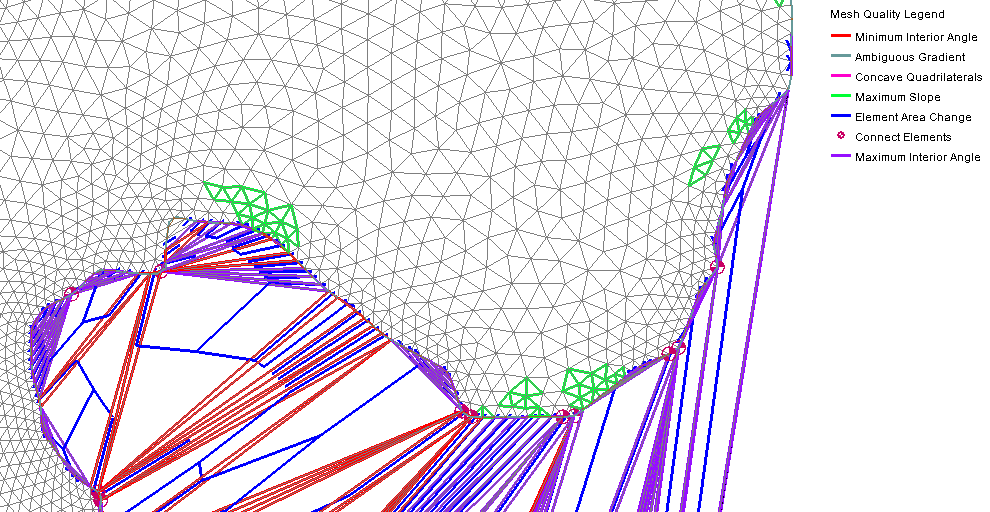
When determining the boundaries of your model, you will need to find two things. First look for the most constricted area when determining model limits. Second, find the furthest usable boundary location from the area of interest. A good rule of thumb for rivers: two floodplain widths up and downstream. Note that the width of the mesh should be greater than the maximum flood width.
Lastly, perform sensitivity analysis on boundary conditions.
Be aware that Manning's n values for 2D model can be lower than 1D models. Be sure to calibrate your model. Essentially check your results to see if they are reasonable.
Following these tips can improve any model that uses a 2D mesh. Try them out in SMS today!
In any groundwater model, knowing how much of the groundwater is available for use determines the fate of any project planned for the area. It is often a crucial part of a model to determine an accurate water budget or flow budget. MODFLOW can calculate its own flow budget and can also make use of the ZONEBUDGET program to calculate the water budget for subregions of a model. Knowing how to use both the MODFLOW flow budget and the ZONEBUDGET program greatly enhances the value of models built in GMS.
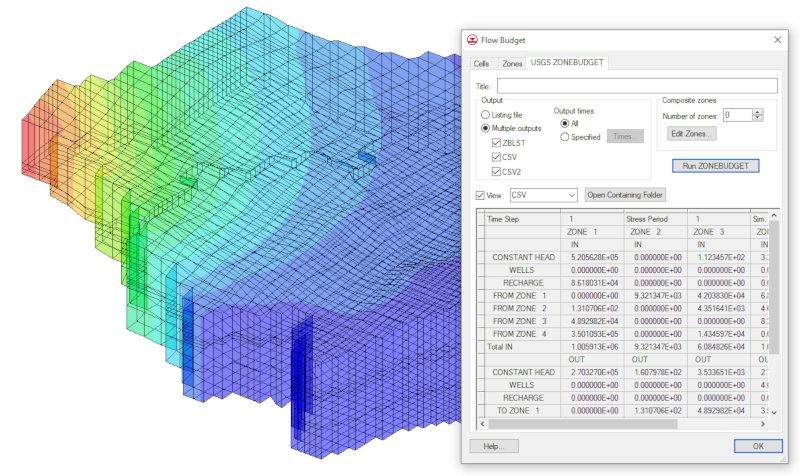
With that in mind, here are some tips for making use of a flow budget and ZONEBUDGET in GMS:
For an overview of ZONEBUDGET in GMS, see our tutorial and try it out in GMS today!
Do you have a project that requires using a large DEM? Digital Elevation Model files are a great source for terrain data in WMS. A lot of projects require using DEMs which makes it important to use the data available.
Using a large DEM file can present some complications in WMS. A large file may cause the program to slow down or have difficulty processing. So it is important to make certain to use a DEM that contains mostly relevant data and doesn’t contain an excess of nonessential information.
But how do you know if the DEM data you are pulling is enough? Is more watershed data always better?
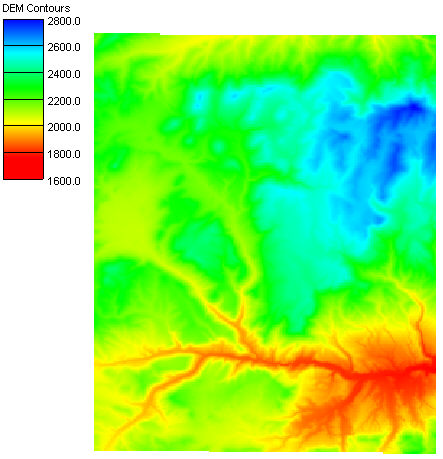
Pulling in more data doesn’t insure better results. Though WMS is able to handle a massive amount of data (which is not a guarantee) the hardware in your computer may not be able to handle it. In general, a DEM twice the size of your watershed is probably sufficient for most models. More than twice your watershed size tends to just bog down the model causing you to face unnecessary wait times.
What should you do if your watershed data is not loading?
If your data is taking a long time to load try adjusting the resolution. After using the Get Data from Map tool, and making your selection in the Data Service Options dialog, you will be able to select your desired resolution in the Zoom dialog. Selecting a lower resolution zoom level should make the DEM easier to work with in WMS.
You could also try breaking up the DEM into multiple DEMs. That way your computer is not overwhelmed by trying to download one huge file all at once. Then while you’re working on your model you can turn on just the DEM(s) you need.
Third party software can be used to break up the DEM or reduce the resolution.
DEMs remain an excellent source for data for projects in WMS. Download WMS today!
The Prune Arc tool is similar to the smooth arc function in SMS. This Smooth Arc tool is useful when eliminating noise from a rough arc, and can make your variations more mathematically stable. This can be extremely handy in working with a model—especially in situations like coastal modelling, which are prone to busy edges. Unfortunately, smoothing an arc can also change the shape of the arc to the point where it no longer matches the actual coastline.
You may come across a situation where your imported arcs have a lot of unnecessary roughness or concave areas that you want to eliminate without redistributing your vertices along the rest of the arc.
If this is the case, the Prune Arcs function is just the tool for the job. This tool trims—or prunes—rough edges and outlying spikes without rounding or reshaping the rest of the arc. Specifically, it allows you to focus on smoothing one side of the arc. This is helpful in coastal modeling where there may be a small river mouth, a harbor, cove or other concave sections that you do not want to include in your model.
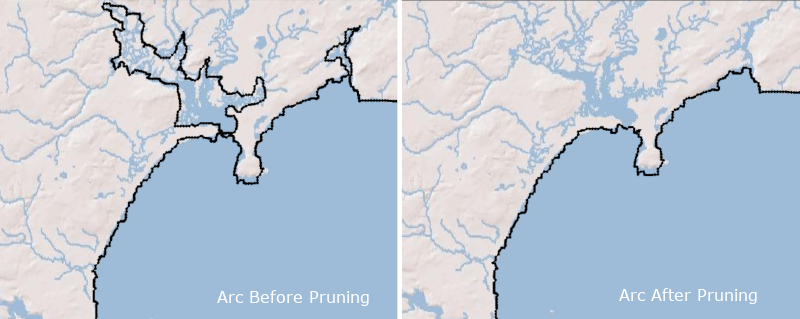
Access the Prune Arc tool by doing the following:
This will bring up the Prune Arcs dialog box, from which you can choose your pruning settings.
There are two types of pruning that can be done: Constant and Spatially Varying.
Importantly, you must choose which side of the arc to prune. The sides of the arc are determined by the arc direction. So if the arc is moving south to north, the left side of the arc will be on the left side of your screen. If the arc is moving west to east, the left side with be towards the top of your screen. Make certain you are pruning the correct side of the arc.
Try out using the Prune Arc tool in SMS 13.0 today!
Have you ever built a model in GMS that uses multiple conceptual models? Doing this offers a few advantages. However, there are potential pitfalls as well when doing this. We will discuss some of the advantages in using multiple conceptual models and what to watch out for.
A conceptual model may contain one or more map coverages. Each coverage should contain feature objects defining key structures of the groundwater model, such as wells, rivers, or recharge. Everything in the conceptual model can then be mapped over to a grid or MODFLOW model.
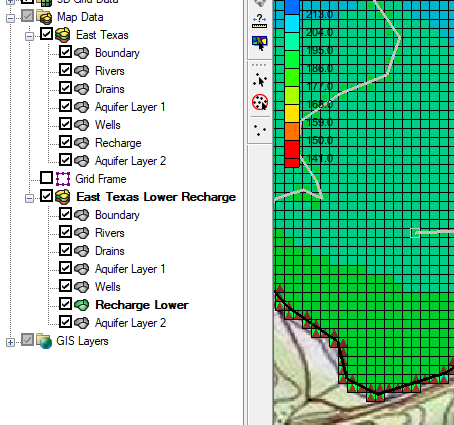
Beyond using folders under a single conceptual model, one of the main advantages with using multiple conceptual models is for organization. When wanting to make variations on a model, it is helpful to have one base conceptual model and then multiple variant conceptual models. The entire base conceptual model may be duplicated to provide a starting point for other variations, or individual coverages may be duplicated and dragged to other conceptual models. Duplicating the base conceptual model can be particularly helpful if you already have transport species defined for MODFLOW-related models.
For example, you can use one conceptual model for a base steady-state model, then create another conceptual model for a transient predictive model. With this you can map the base conceptual model to MODFLOW and run that model. After you have the base results, you can duplicate the solution datasets to preserve them, adjust Global Options—such as Stress Periods—if needed, and then map the predictive model to the grid to run your second MODFLOW model.
When using multiple conceptual models, there are few items to look out for. These include:
Working with multiple conceptual models can expand your options for your model. Try out the conceptual model and other features of GMS today!